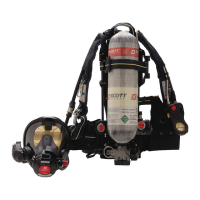17
WARNING
FAILURE TO DON THE FACEPIECE AND/OR
FAILURE TO ADJUST THE HEAD HARNESS
AS DESCRIBED IN THIS INSTRUCTION MAY
RESULT IN A POOR FACE TO FACEPIECE
SEAL OR MAY RESULT IN THE FAILURE OF
THE FACE TO FACEPIECE SEAL DURING
USE. A POOR OR FAILED FACE TO FACE-
PIECE SEAL MAY REDUCE THE DURATION
OF USE OF THE RESPIRATOR AND/OR EX-
POSE THE USER TO THE HAZARDOUS
ATMOSPHERE WHICH COULD RESULT IN
SERIOUS INJURY OR DEATH.
WARNING
FIT TESTING IN ACCORDANCE WITH OSHA
STANDARD 29 CFR PART 1910 IS RE-
QUIRED AS PART OF THE REQUIRED
TRAINING BEFORE USE OF THIS RESPIRA-
TOR. FAILURE TO PROPERLY FIT AND
TRAIN THE USER IN USE OF THE FACE-
PIECE AND RESPIRATOR MAY RESULT IN
EXPOSURE TO THE HAZARDOUS ATMO-
SPHERE WHICH COULD LEAD TO SERIOUS
INJURY OR DEATH.
USE OF RESPIRATOR
Training and fit testing are required before use of this equipment.
If respirator use is expected at temperatures near or below freezing,
or if respirator is to be used after being kept at temperatures near or
below freezing, refer to LOW TEMPERATURE OPERATION Section
for additional information and supplemental procedures.
If regulator is not attached to facepiece, be sure the regulator gasket is in
place around the outlet port of the regulator and not damaged. With the
red purge valve in the 12 o’clock position, align the two flats of the outlet
port with corresponding flats in the facepiece port and insert. Rotate the
regulator counterclockwise (viewed from inside of facepiece) so that the
red purge valve knob is situated on the left side of the facepiece. The lock
tab on the mask-mounted regulator will lock into the facepiece retainer
with a “click.” If properly engaged, the regulator will not rotate.
To begin use of respirator, don the facepiece (i.e., place facepiece
on face and obtain a proper seal) as follows:
1. Examine the facepiece assembly to be certain the nose cup in-
halation valves are installed, the nose cup is correctly positioned
inside the face seal chin cup, and nose cup is properly seated be-
tween the flanges of the voicemitter ducts. See FIGURES 9 and
10 in the STANDBY INSPECTION, CLEANING AND STORAGE
section of this instruction.
2. Adjust the head straps to the full outward position.
3. Hold the head harness out of the way with one hand while plac-
ing the facepiece on the face with the other hand.
NOTE
ENSURE THAT THE CHIN IS PROPERLY LOCATED IN THE CHIN
POCKET OF THE FACEPIECE.
4. Pull the head harness over the head and ensure that straps are
lying flat against the head and neck with no twists.
NOTE
IF THE FACEPIECE IS EQUIPPED WITH A RUBBER HEAD HAR-
NESS, POSITION THE TOP CENTER PORTION OVER THE CROWN
OF THE HEAD. MAINTAIN THE HEAD HARNESS IN THIS POSITION
WHILE TIGHTENING THE STRAPS.
5. Tighten the neck straps by pulling the two lower strap ends to-
ward the rear of the head.
6. Verify that the head harness is lying flat against the back of the
head using one or both hands. Retighten neck straps.
7. Adjust the temple straps by pulling the two upper strap ends to-
ward the rear of the head. Use caution pulling temple straps as
overtightening may cause discomfort.
8. Retighten the neck straps if required. On subsequent use by the
same wearer, release and retightening of the temple straps may
not be required.
9. With facepiece sealed to face, inhale sharply to actuate respira-
tor. Air will then be supplied during inhalation.
NOTE
IF AIR IS NOT SUPPLIED ON FIRST INHALATION, CHECK THAT
CYLINDER VALVE IS FULLY OPEN, REMOTE GAUGE INDICATES
PRESSURE IN CYLINDER, AND FACEPIECE IS SEALED TO FACE.
USE OF THE RESPIRATOR
CONTINUED ON NEXT PAGE...

